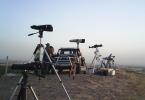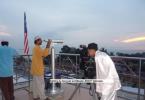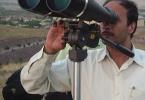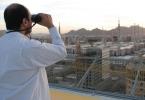Most Muslim countries started the month of Sha’ban on Tuesday July 13, so they will be looking for the new crescent of the month of Ramadan on August 10, even though it will not be possible to sight the crescent on that evening by naked eye or using by telescopes from anywhere in Asia, Europe, and most of Africa.
The crescent moon could be observed by telescopes in the southern and south-western regions of Africa and in Central and South America. Most importantly, it could only be seen by naked eye (on Aug. 10) in South America (see the map below). With these possibilities, we may expect some Muslim countries to start the month of Ramadan on Wednesday, August 11, 2010. However, countries which require the sighting of the crescent to be made from within their borders or regions can be expected to start the month of Ramadan on Thursday August 12.
Other Muslim countries, like Pakistan and Morocco, started the month of Sha’ban on July 14th; they will be looking for the Ramadan crescent on the 11th of August and thus starting the month on Thursday August 12th, the crescent being easily visible on the evening of Aug. 11.
The Islamic Crescents Observation Project (ICOP) is also happy to announce that a new technology for seeing/imaging the crescent moon was successfully used at the start of the month of Sha’ban, on Monday, July12. This new technology/method uses a telescope equipped with a special video camera, all controlled by a computer with a program which records and processes the hundreds of images taken. This technology then allows us to image a crescent that would be practically impossible to see using the traditional methods, i.e. naked eyes or “normal” telescopes.
ICOP experts used this method to observe the crescent moon of Sha’ban in Abu Dhabi, United Arab Emirates, on Monday, July 12th starting in the morning until the successful sighting at 7:07 pm, i.e. 5 minutes before Maghrib/Sunset. It is also worth reporting that the traditional methods, naked eye and telescope, were used without success despite the relatively clear sky on that day. This stresses the importance of this new astronomical/numerical imaging technique, as it allows the sighting of the crescent moon when the old methods (naked eyes, binoculars, telescopes) do not permit it, as well as the fact that the sighting was performed before Sunset.
Given the importance of this new technique, a number of neighboring Muslim countries have started building specialized observatories for the sighting of the crescent moon using this technology. We may now say that we have three different ways of sighting the crescent moon: naked eyes, binoculars and telescopes, and numerical (CCD) imaging. The latest technique, however, still needs to be ascertained from the perspective of Sharia.
The Islamic Crescents Observation Project (ICOP) plans, In Shaa Allah, to use this technology to sight the crescent moon for the start of the month of Ramadan along with the traditional methods. Indeed, there is a substantial probability for sighting the crescent moon on August 10th using this technique, while the other methods will not allow that.
To put the above data in perspective, one needs to know that the shortest time a crescent moon was seen with naked eyes was 29 minutes after Sun set and this was done on September 20, 1990 in Palestine, and the youngest moon which was seen with naked eyes was 15 hours and 33 minutes old, and this took place on the 25th of February 1990 in the United States. Other parameters which affect the sighting of the crescent moon are the proximity of the crescent to the Sun at the time of sunset and its height above the horizon.
To find out more about crescent observation for the month of Ramadan and ICOP, please visit: www.icoproject.org. ICOP was established in 1998 and has more than 400 members (scientists, scholars, experts, and amateurs interested in crescent observations and calendars). We encourage anyone who is interested in such topics, from anywhere in the world, to observe the crescent and send their results to ICOP through the above website.
For the ICOP’s Administrative Board,
Mohammad Odeh (President)
















